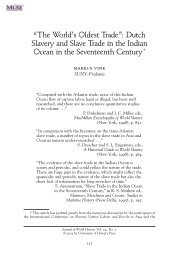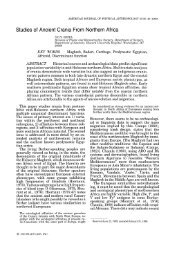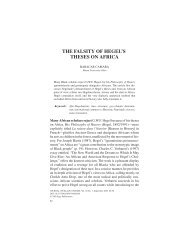GENETICS, EGYPT, AND HISTORY: INTERPRETING ...
GENETICS, EGYPT, AND HISTORY: INTERPRETING ...
GENETICS, EGYPT, AND HISTORY: INTERPRETING ...
Create successful ePaper yourself
Turn your PDF publications into a flip-book with our unique Google optimized e-Paper software.
226 S.O.Y. Keita and A. J. Boyce<br />
being the descendants of immigrant Near Eastern Jewish communities,<br />
whose males have high frequencies of VII and VIII collectively (Tables<br />
2A, 2B). Ironically, a noteworthy frequency of VIII has been found in a<br />
non-Jewish Ethiopian population, and this is likely due to the known<br />
interactions with Arabia in the past (see Munro-Hay 1991), with some<br />
likely amplification by genetic drift.<br />
Given these findings, it is more accurate to call V “Horn-supra-saharan<br />
African,” not ‘Arabic;’ it is indigenous to Africa. The first speakers of<br />
Arabic, a Semitic language, came into Africa from the Near East. Using<br />
the same logic as applied to the Falasha, supra-Saharan Africans are primarily<br />
(but not solely) Arabic-speakers, due to language and cultural<br />
shift, and not settler colonization, as has been stated before based on biallelic<br />
lineage data (Bosch et al. 2001). High frequencies of VII and VIII<br />
characterize the indigenous core Arabic-speaking peoples of the Near<br />
East, and Jews also as noted (Tables 2A, 2B) (Lucotte and Mercier<br />
2003b, al-Zahery et al. 2003, Lucotte et al. 1996, Lucotte et al. 1993,<br />
Santichiara-Benerecetti et al. 1993). There was no wholesale population<br />
replacement. This is not especially surprising because there is no evidence<br />
that the earliest Arabic-speakers, who came as teachers of Islam, intended<br />
to replace the indigenous populations biologically.<br />
There is further evidence from a phylogeographic perspective for the<br />
biohistorical Africanity of haplotype V. Biallelic markers on the nonrecombining<br />
portion of the Y chromosome define clades that can be associated<br />
with the TaqI p49a,f variants (see e.g. al-Zahery et al 2003, who<br />
present a kind of genetic Rosetta stone). Haplotype V is associated with<br />
the M35/215 subclade, as is XI (in Africa), and IV with the<br />
M2/PN1/M180 subclade, both of the YAP/M145/M213 cluster. These<br />
lineages (“subclades”) subsuming haplotypes V/XI and IV, are joined by a<br />
transition mutation: “most notably the PN2 transition . . . unites two<br />
high frequency sub-clades, defined by M2/PN1/M180 mutations in sub-<br />
Saharan Africa, and M35/215 in north and east Africa.” (Underhill et al.<br />
2001:50). In one system of Y haplotype taxonomy, the subclades are in<br />
Group III (Bosch et al. 2001, Cruciani et. al. 2002). In another system of<br />
classification, these lineages are in haplogroup E (Hammer and Zegura<br />
2002). The PN2 transition therefore defines a widespread clade. It is<br />
noteworthy that Group III is said to account for 73% of the variation in<br />
Africa (Underhill et al. 2001).<br />
A limited review of Y chromosome studies for supra-Saharan Africa<br />
demonstrates a consistency with each other once equivalences are determined.<br />
There is a modal frequency of particular lineages from Egypt to<br />
Morocco that is distinct from those in the Near East, Europe, and tropi-


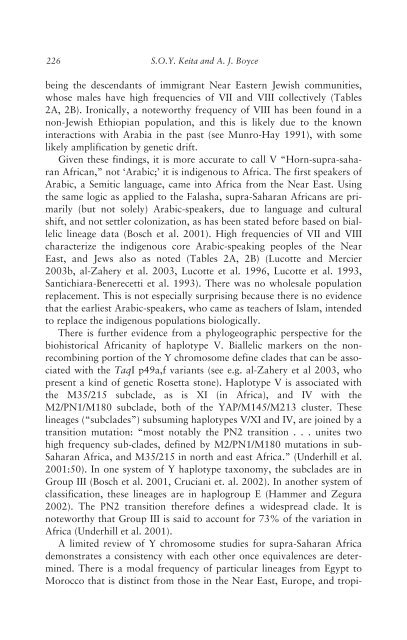

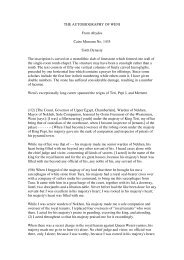
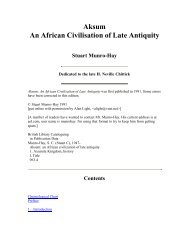

![The Negro trail blazers of California [microform] : a ... - Homestead](https://img.yumpu.com/32436613/1/174x260/the-negro-trail-blazers-of-california-microform-a-homestead.jpg?quality=85)
